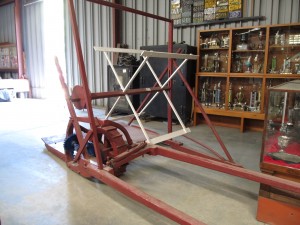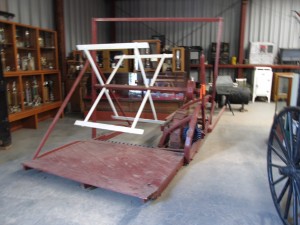Cyrus McCormick built and demonstrated a mechanical reaper in 1831. Up to that time standing grain had to be cut with a scythe and then gathered by hand to be tied into sheaves and stooked for drying. As well sheaves were often carried off to a barn for drying.
After drying, threshing could take place either with a fail or a ground hog thresher. Some scythes were equipped with a lightweight carrier that caught the plants as they were cut. This had the advantage that the stalks of grain were already gathered and so were more easily tied into sheaves. But this method was laborious and cutting the crop was the limiting factor in grain production. The most a single farmer could hope to harvest with a scythe was around 10 acres if the farmer was working by himself. The years after 1800 saw people becoming more aware of how machines could improve their lives and make them money. Agriculture was no exception, and people were examining how agriculture could be mechanized.

Cyrus McCormick was born in 1809 in the Shenandoah Valley of Virginia where his father operated a large farm or plantation at the time. His father around 1801 purchased the idea for a mechanical reaper from a blacksmith named McPhetrich. Mr. McCormick worked on this idea for the next 28 years but was never able to perfect it into a viable horse drawn machine. Cyrus McCormick took over the project in 1830 and with the help of an enslaved African American on the McCormick plantation, Joe Anderson, Cyrus came up with a mechanical reaper. As the machine could not handle variable conditions well, it did not sell.
Cyrus only sold the first machine in 1840, none in 1841 and another seven in 1842. Sales after that time slowly began to pick up. These early machines were built by hand in the plantation workshop. Improvements were made to the design in 1845 and in 1847 Cyrus and a brother moved to Chicago where they established a factory to build reapers. Chicago offered cheap transportation for raw materials and easy access to the farms of the US Mid-West which Cyrus had noticed were the farms purchasing his machines. At this time the company was called the Cyrus H. McCormick and Brothers Company. It later became the McCormick Harvesting Machine Company. In 1902, McCormick was merged into the International Harvester Company. It should be noted that other inventors were working on reapers at the time. Robert Bell of Scotland, Obed Hussey and John Manny of the USA are a few inventors working on early reaper designs. Bells’ work predates McCormicks and a few of Bells machines, a horse pushed machine, had been sold in the US before 1831.

The early reaper offered farmers the ability to harvest more than 10 aces of grain however a machine like McCormick’s first reaper still involved significant hand labour. The grain was cut by a ground driven sickle which later become to be known as a knife and fell on to a platform behind the knife. The farmer walked alongside the machine and raked the stalks off the platform onto the ground. Probably one attempted to rake the material off in small bunches so as to facilitate tying the stalks into sheaves. Later the self-raking reaper was developed and from this machine was developed the grain binder which cut the grain and then bound the stalks into sheaves. In 1931, the International Harvester Company (IHC) made a number of replicas of the original 1831 McCormick reaper as promotional items. These replicas were donated to various agricultural Colleges and Universities, the University of Manitoba being one of these institutions. In the late 1950s, the University of Manitoba donated its replica reaper to the Museum. While it is not an exact replica of the 1831 machine it follows the general principals of the original and like the original is entirely handmade with some parts hewn with an axe.
Reapers first seem to have appeared in Manitoba in the 1870s and are thought to be of the self-raking type. However it not beyond the realm of possibility that a machine like this was used in Manitoba. Records kept of the time are not detailed enough that machine models were recorded. The replica fills in a gap between the scythe and the self-raking reaper of which the Museum has several, this replica is a valuable addition to the Museum collection.

































